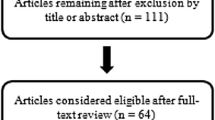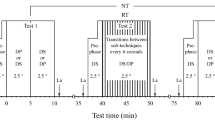Abstract
Purpose
The purpose of this study was to determine self-selected speeds, metabolic rate, and gross metabolic cost during longboard skateboarding.
Methods
We measured overground speed and metabolic rate while 15 experienced longboarders traveled at their self-selected slow, typical and fast speeds.
Results
Mean longboarding speeds were 3.7, 4.5 and 5.1 m s−1, during slow, typical and fast trials, respectively. Mean rates of oxygen consumption were 24.1, 29.1 and 37.2 ml kg−1 min−1 and mean rates of energy expenditure were 33.5, 41.8 and 52.7 kJ min−1 at the slow, typical and fast speeds, respectively. At typical speeds, average intensity was ~8.5 METs. There was a significant positive relationship between oxygen consumption and energy expenditure versus speed (R 2 = 0.69 (P < 0.001), and R 2 = 0.78 (P < 0.001), respectively). The gross metabolic cost was ~2.2 J kg−1 m−1 at the typical speed, greater than that reported for cycling and ~50 % smaller than that of walking.
Conclusion
These results suggest that longboarding is a novel form of physical activity that elicits vigorous intensity, yet is economical compared to walking.




Similar content being viewed by others
Abbreviations
- ACSM:
-
American College of Sport Medicine
- ANOVA:
-
Analysis of variance
- GPS:
-
Global positioning system
- Hz:
-
Hertz
- J:
-
Joules
- kg:
-
Kilogram
- km:
-
Kilometer
- kJ:
-
Kilojoule
- MET:
-
Metabolic equivalent
- m:
-
Meter
- min:
-
Minute
- ml:
-
Milliliters
- MPH:
-
Miles per hour
- s:
-
Second
- SEE:
-
Standard error of the estimate
References
American College of Sports Medicine (2006) ACSM’s guidelines for exercise testing and prescription, 7th edn. Appendix D. Williams and Wilkins, Baltimore
Bellizzi MJ, King KA, Cushman SK, Weyand PG (1998) Does the application of ground force set the energetic cost of cross-country skiing? J Appl Physiol 85:1736–1743
Bornstein MH, Bornstein BH (1976) The pace of life. Nature 259:557–559
Brockway J (1987) Derivation of formulae used to calculate energy expenditure in man. Hum Nutr Clin Nutr 41(6):463–471
Browning RC, Baker EA, Herron JA, Kram R (2006) Effects of obesity and sex on the energetic cost and preferred speed of walking. J Appl Physiol 100:390–398
Burke E (2002) Serious cycling. In: Human kinetics, 2nd edn. Champaign, IL, pp 28–35
di Prampero P (1986) The energy cost of human locomotion on land and in water. Int J Sports Med 7:55–72
Dill J (2009) Bicycling for transportation and health: the role of infrastructure: the role of the infrastructure. J Public Health Policy 30(Suppl 1):S95–S110
Formenti F, Ardigò LP, Minetti AE (2005) Human locomotion on snow: determinants of economy and speed of skiing across the ages. Proc R Soc B Biol Sci 272:1561–1569
Frank LD (2000) Land use and transportation interaction implications on public health and quality life. J Plan Educa Res 20:6–22
Frank LD, Engelke PO (2001) The built environment and human activity patterns: exploring the impacts of urban form on public health. J Plan Lit 16(2):202–218
Hetzler RK, Hunt I, Stickley CD, Kimura IF (2011) Selected metabolic responses to skateboarding. Res Q Exerc Sport 82(4):788–793
Inman VT, Ralston HJ, Todd F (1994) Human locomotion. In: Rose J, Gamble JG (eds) Human walking, 2nd edn. Williams and Wilkins, Baltimore, pp 2–22
Kruger J, Ham SA, Berrigan D, Ballard-Barbash R (2008) Prevalence of transportation and leisure walking among U.S. adults. Prev Med 47(3):329–334
Kvamme B, Jakobsen V, Hetland S, Smith G (2005) Ski skating technique and physiological responses across slopes and speeds. Eur J Appl Physiol 95:205–212
Martin PE, Rothstein DE, Larish DD (1992) Effects of age and physical activity status on the speed-aerobic demand relationship of walking. J Appl Physiol 73(1):200–206
Melanson EL, Freedson PS, Webb R, Jungbluth S, Kozlowski N (1996) Exercise responses to running and in-line skating at self-selected paces. Med Sci Sports Exerc 28(2):247–250
Minetti AE, Pinkerton J, Zamparo P (2001) From bipedalism to bicyclism: evolution in energetics and biomechanics of historic bicycles. Proc R Soc B Biol Sci 268:1351–1360
Oja P, Vuori I, Paronen O (1998) Daily walking and cycling to work: their utility as health-enhancing physical activity. Patient Educ Couns 33:S87–S94
Ralston HJ (1958) Energy-speed relation and optimal speed during level walking. Arbeitsphysiologie 17(4):277–283
Rey-López JP, Vicente-Rodríguez G, Biosca M, Moreno LA (2008) Sedentary behaviour and obesity development in children and adolescents. Nutr Metab Cardiovasc Dis 18(3):242–251
Rosdahl H, Gullstrand L, Salier-Eriksson J, Johansson P, Schantz P (2010) Evaluation of the oxycon mobile metabolic system against the Douglas bag method. Eur J Appl Physiol 109(2):159–171
Rubenson J, Heliams DB, Maloney SK, Withers PC, Lloyd DG, Fournier PA (2007) Reappraisal of the comparative cost of human locomotion using gait-specific allometric analyses. J Exp Biol 210(pt 20):3513–3524
Saelens BE, Sallis JF, Frank LD (2003) Environmental correlates of walking and cycling: findings from the transportation, urban design, and planning literatures. Ann Behav Med 25(2):80–91
Sallis JF, Frank LD, Saelens BE, Kraft MK (2004) Active transportation and physical activity: opportunities for collaboration on transportation and public health research. Trans Res Part A Policy Pract 38(4):249–268
Tucker VA (1975) The energetic cost of moving about: walking and running are extremely inefficient forms of locomotion. Much greater efficiency is achieved by birds, fish and bicyclists. Am Sci 63(4):413–419
Acknowledgments
This research was supported by a grant from AEND Industries.
Conflict of interest
The authors declare that they have no conflict of interest.
Ethical standards
This experiment complies with the current laws of the United States of America.
Author information
Authors and Affiliations
Corresponding author
Additional information
Communicated by Guido Ferretti.
Rights and permissions
About this article
Cite this article
Board, W.J., Browning, R.C. Self-selected speeds and metabolic cost of longboard skateboarding. Eur J Appl Physiol 114, 2381–2386 (2014). https://doi.org/10.1007/s00421-014-2959-x
Received:
Accepted:
Published:
Issue Date:
DOI: https://doi.org/10.1007/s00421-014-2959-x




